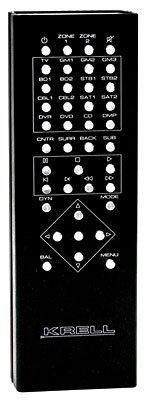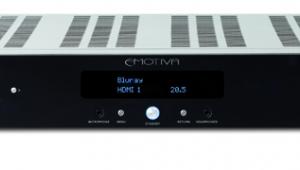Krell Foundation Surround Processor

AT A GLANCE
Plus
Superb sonics
High build quality
No widgets, gimmicks, or extraneous features
Minus
No widgets, gimmicks, or extraneous features
Klunky OS, incomplete instructions, non-backlit remote
THE VERDICT
Krell’s aptly named, sonically sophisticated Foundation counters a foolish industry trend toward sacrificing sound quality for useless and/or redundant features.
We live in a bizarre world where automobile commercials tout peripheral accessories while omitting mention of engines, transmissions, and brakes. What’s more important: Stopping distance or voice-activated Bluetooth?
So it’s not surprising that in much of today’s home theater electronics, sound quality takes a backseat to features and widgets. Backseat? In some, sound quality doesn’t even go along for the ride.
Krell’s new Foundation 7.1-channel processor—the company’s least expensive—eschews the widgets and gadgets in favor of sound quality—not that the Foundation is bereft of useful features.
By making use of technology and circuitry originally developed for the $30,000 flagship Evolution 707 and scaling back the rugged chassis, the massive milled-aluminum faceplate, and full feature set, Krell brings to market a $6,500 pre/pro that is said by the company to sustain its reputation for superior sound quality.
Features You Get
While the Foundation lacks the Evolution’s visual flash, it’s still a handsome-looking piece with a smartly arranged front panel that’s sized to fit on a standard-width and -height shelf or rack. Obviously, it decodes Dolby Digital, Dolby Digital Plus, Dolby TrueHD, DTS, DTS-ES Discrete, Matrix, and DTS-HD Master Audio, in addition to Dolby Pro Logic IIx, DTS Neo:6, and high-resolution PCM as well as Krell’s proprietary surround modes: Party, General Admission, Front Row, and On Stage.

It offers nine rear-panel HDMI 1.4a inputs and one on the front panel, plus two ARC-capable HDMI outputs to transmit sound from your monitor’s Netflix and other widgets back to the Foundation.
Also included are two composite and three component video inputs, as well as three each coaxial and optical digital inputs. You’ll also find RCA single-ended and balanced analog stereo inputs, and both RCA and balanced outputs for all seven channels plus two subs. All the video inputs are strictly for switching—the Krell does no upconversion on any incoming signal.
The Foundation can connect via Ethernet cable only (no Wi-Fi) to the Internet, and only for software updates (a few occurred during the review period, though you have to regularly look for them since there’s no onscreen alert). Once connected to your network, you can type the Foundation’s IP address into an iPad Web browser to access a virtual remote control panel. It also includes an RS-232 control port for use with home-automation systems. The included non-backlit remote control is a heavy affair, built from extruded aluminum with multiple rows of silver buttons.
Krell also includes its proprietary ARES Automatic Room Equalization System used in conjunction with a supplied microphone for both initial automatic speaker setup and optional equalization. The EQ function can be set to full range or limited to selectable lower frequencies. A second audio zone lets you simultaneously play different audio in two locations.
 Features You Don’t Get
Features You Don’t Get
As noted above, other than transcoding the two composite and three component video inputs so they can pass via HDMI, the Foundation does not do any video processing. It doesn’t scale to 4K, but it does pass video up to 1080p/60 bit for bit. There’s no onscreen menu system or onscreen anything.
Also, you don’t get height or width channels, an AM/FM tuner, XM/Sirius, Netflix, Pandora, or any widgets whatsoever. It’s not THX approved or kosher for Passover, nor does it have a 5.1-channel analog input, which is a notable omission in a $6,500 pre/pro but will only affect users who own high-performance, multichannel SACD or Blu-ray players with built-in high-end DACs that exceed the performance of the Krell’s own circuitry (see below). The Foundation doesn’t have Bluetooth or AirPlay or USB iPod connectivity, though here you could add one of the higher-quality Bluetooth adapters to gain the ability to stream straight from a phone or tablet.
Innovative Circuit Architecture You Do Get
The number-crunching heart is based upon a pair of dual-core 32-bit Cirrus Logic CS497024 DSPs performing 1.8 giga-operations per second. Digital signals are then routed to 32-bit ESS Sabre DACs. Proprietary Krell preamp circuitry is discrete current-based Class A, direct coupled with no op-amps or ICs in the signal path. Analog inputs bypass digital circuitry and are routed directly to a balanced ladder resistor-type volume control.
What is said to be Krell-developed “intelligent” HDMI switching uses circuit- and software-based solutions to produce near instantaneous switching among the ten HDMI inputs, all of which are always active. The system stores in its non-volatile memory useful information such as individual source resolution and audio formatting. Although I never had more than two or three HDMI sources connected simultaneously, it worked as promised.
Clunky Setup
Buy a Krell, and your dealer will most likely do the setup, but if you’re used to some of the more elegant setup systems found on far less expensive pre/pros, you’ll find the Foundation’s less so, especially since there’s no onscreen menu system.
- Log in or register to post comments


Thank you for the article. I am intrigued particularly by your mention of the Cary 11. I've been considering the Cary Cinema 12 because it to seems to have superior sound quality, so I'm wondering how this Krell and the Cinema 12 would compare for sound quality.
With my current receiver, whose name will remain unwritten, I have to use the Oppo's analog out in 2 or 5.1 to get higher audio resolution.
The Oppo uses Sabre 32 Dacs and plays DSD 2 and 5.1 and if I'm reading the manual correctly (I just got it and am still in the new and explore stage) I have to use the analog out to get full audio resolution.
Would this Krell be fully compatible with the Oppo? Is it fair to ask you for a sound quality comparison with Marantz 8801 and Mac 121?
I'm interested in vinyl play back too!
It isn't easy, as a customer, to find these brands within a reasonable driving distance. Even when you do find them the rooms are set up so differently! I was recently in an audition room that seemed to totally deaden the audio, rolling off highs and lows creating an environment that to my ear didn't sound natural at all! The next listening room had little or no sound treatment. Wow what a contrast that was.
Thanks for any more info you can give.

The Krell does not incorporate a 5.1 channel input so for surround DSD you'd be out of luck unless you've misread the Oppo manual and its HDMI connection can output DSD (I do not know if that's possible) but you can run DSD two-channel into the Krell. As good as is the Marantz, the Krell is in a different league. Since the Mac 121 was reviewed as a complete system a comparison is impossible. That's about all I can say but I suspect the lack of 5.1 channel analog inputs will be a deal breaker for you. As for a Cary 12 comparison I can only compare to the Cary Cinema 11 and it was here a long time ago. It is certainly in the same "ball park" as the Krell but beyond that I can't say anything with certainly.

"You can run DSD decoded analog into the Krell, not DSD.

If you MUST have sources/integration/streaming like Spotify, Pandora, AirPlay, et al.... just patch-in an AVR for those features. If you are buying this pre/pro, you probably have the space and budget for seamless integration.
The point? When not using those sub-par formats, you get awesome audo and HT from the Krell and you can cheaply upgrade when new features arrive.
I bet, however, that a buyer pursuing this level of audio performance, has a dedicated HT and doesn't need those sources in that room. Perhaps they get them from distributed audio in other rooms?

Mr Fremer,
After re-reading your article I see you actually anticipated my questions about commercial brands such as Marantz and Macintosh, and I've answered my own question about Oppo compatibility.
I fully agree about redundant features. How many different pieces do I need that connect to Pandora and Netflix? Isn't the connectivity of apple tv, the panasonic tv, and the oppo blue ray player enough? None seem to have MOG:-(
Still, since this Krell combined with the matching Amp are too expensive for my budget, I am wondering about how the very well reviewed, on this website, Cary Cinema 12 stacks up to this piece.
Is there an amp less expensive then the Krell 7200 that would work well with this piece?
After reading your review I can't wait to hear the Foundation personally. Tomorrow I hope! If it sounds as spectacular as you indicated my wife may kick me out of the house...

My listening was with a Parasound Halo A51 that you can get for around $4500. The Krell 7200 may be better (or not!) but the combo I reviewed is missed here every day. Well I have the amp….

Mr. Fremer, Thank you for your comments about the Krell Foundation, Cary 12 etc:
Thought you’d be interested in Krell’s response to my question about DSD:
Thanks for your communication and also for your interest in the Krell Foundation preamp/processor. At some point later on this year, most likely coinciding with the implementation of 4K in the Foundation, the Foundation will also get the ability to decode a DSD signal via HDMI. We do not have an exact time line for when this will occur but it is something that we are working on right now.

Hey. Anyone have any suggestions as to the best cables to use for the krell pre-pro setup? I'm looking for best performance on the upper-end price point (not the super budget or budget cables, but not cost is no object either). Also, it would be great if you added a top picks for cables to go along with the a/v equipment. Thank you.




































































